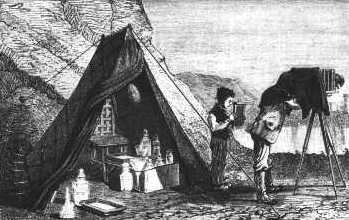
In 1851 the Wet Collodion Process was introduced by Frederick Scott
Archer. In this process a glass plate was coated with wet collodion and
then sensitized by dipping it into a bath of silver nitrate, then while
still wet it was placed in the camera and an exposure was made. The plate
was then immediately developed, while still wet, to form the negative.
The wet collodion process was also used to make another form of photograph.
The Ambrotype. These ambrotypes were simply
a wet collodion negative viewed with a dark background (sometimes a black
lacquer or black velvet) behind them.
In 1853 the wet collodion process was used with black enameled iron
and these were called Ferrotypes or Tin types.
Smaller tintypes were called Gemtypes.
These ferrotypes or tintypes were very popular in America and were
not introduced to Europe until the late 1870's and were then classed only
as a beach photographer's novelty.